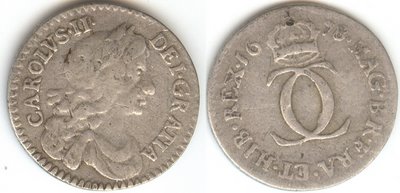Charles II (30 Jan 1649 - 6 Feb 1685) Coinage And History

As yesterday, I Showed some Charles I coins, I thought it would make some sense to show one from when his son Charles II was restored to The Monarchy. The following coin is a Charles II twopence from 1678 along with some background information.
HOUSE OF STUART
Charles II (30 Jan 1649 - 6 Feb 1685) - born 29th May 1630 - one marriage with no offspring
Several ill fated attempts to regain his inheritance from his father failed, as his armies were routed by the well organised Cromwell. A young Charles had to flee the country as the power of the Commonwealth steadily but surely took over, famously hiding in an oak tree en route to France. The restoration of the monarchy was negotiated by General George Monk who called for new elections, following a revival of royalist feeling in 1660. Charles II ascended to the throne after being recalled from his exile and the Restoration began on 29th May 1660. He was married in 1662 to Catherine Henrietta daughter of John IV Duke of Braganza, but failed to produce an heir. He did have sixteen illegitimate issue though after amorous affairs with various women including Nell Gwynn and Louise, duchess of Portsmouth. Charles was a keen horseman and actually rode several winners at Newmarket himself. He died aged 54 from complications following a stroke.
His reign was most important numismatically for the permanent introduction of machine made “milled” coinage from 1662 and for the introduction of a copper regal coinage of halfpennies and farthings from 1672 after the withdrawal of tradesman’s tokens. The hammered coinage finished being produced in early 1662, and the Roettier family designed the new coinage replacing Thomas Simon who was relegated to designing only the small silver coins and medallions. The major new milled denomination was the Guinea with it’s multiples and fractions which was valued at this time at twenty shillings. The silver denominations were the same as for Cromwell with the Sixpence in addition with the small silver from groat to penny. Some of the silver shillings have a plume on the centre of the reverse sometimes with a plume on the obverse as a mint mark, this indicates the silver came from Wales. Some of the gold coinage has an elepant below the bust indicating the gold came from Guinea in Africa.











No comments:
Post a Comment